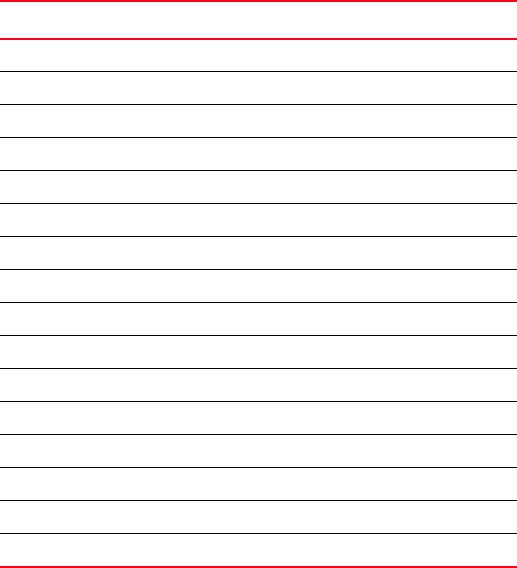Brocade Converged Enhanced Ethernet Administrator's Guide v6.1.2_cee (53-1001258-01, June 2009)
Table Of Contents
- Contents
- Figures
- Tables
- About This Document
- Introducing FCoE
- Using the CEE CLI
- In this chapter
- CEE CLI configuration guidelines and restrictions
- Using the CEE command line interface (CLI)
- CEE CLI RBAC permissions
- Accessing the CEE CLI through the console interface or through a Telnet session
- Accessing the CEE CLI from the Fabric OS shell
- Accessing CEE CLI command modes
- Using CEE CLI keyboard shortcuts
- Displaying CEE CLI commands and command syntax
- Using CEE CLI command completion
- CEE CLI command syntax conventions
- Using CEE CLI command output modifiers
- Configuring VLANs Using the CEE CLI
- In this chapter
- VLAN overview
- Ingress VLAN filtering
- VLAN configuration guidelines and restrictions
- Default VLAN configuration
- VLAN configuration procedures
- Enabling and disabling a CEE interface
- Configuring the MTU on a CEE interface
- Creating a VLAN interface
- Configuring a VLAN interface to forward FCoE traffic
- Configuring a CEE interface as a Layer 2 switch port
- Configuring a CEE interface as an access interface or a trunk interface
- Configuring VLAN classifier rules
- Configuring VLAN classifier groups
- Associating a VLAN classifier group to a CEE interface
- Clearing VLAN counter statistics
- Displaying VLAN information
- Configuring the MAC address table
- Configuring STP, RSTP, and MSTP using the CEE CLI
- In this chapter
- STP overview
- RSTP overview
- MSTP overview
- STP, RSTP, and MSTP configuration guidelines and restrictions
- Default STP, RSTP, and MSTP configuration
- STP, RSTP, and MSTP configuration procedures
- STP, RSTP, and MSTP-specific configuration procedures
- STP and RSTP-specific configuration procedures
- RSTP and MSTP-specific configuration procedures
- MSTP-specific configuration procedures
- 10-Gigabit Ethernet CEE interface-specific configuration
- Global STP, RSTP, and MSTP-related configuration procedures
- Clearing STP, RSTP, and MSTP-related information
- Displaying STP, RSTP, and MSTP-related information
- Configuring Link Aggregation using the CEE CLI
- Configuring LLDP using the CEE CLI
- Configuring ACLs using the CEE CLI
- In this chapter
- ACL overview
- Default ACL configuration
- ACL configuration guidelines and restrictions
- ACL configuration procedures
- Creating a standard MAC ACL and adding rules
- Creating an extended MAC ACL and adding rules
- Modifying a MAC ACL
- Removing a MAC ACL
- Reordering the sequence numbers in a MAC ACL
- Applying a MAC ACL to a CEE interface
- Applying a MAC ACL to a VLAN interface
- Clearing MAC ACL counters
- Displaying MAC ACL information
- Configuring QoS using the CEE CLI
- Configuring FCoE using the Fabric OS CLI
- Administering the switch
- Configuring RMON using the CEE CLI
- Index

118 Converged Enhanced Ethernet Administrator’s Guide
53-1001258-01
Converged Enhanced Ethernet
8
Converged Enhanced Ethernet
The CEE QoS covers packet classification, priority and traffic class (queue) mapping, congestion
control, and scheduling. Under the CEE Provisioning model all of these features are configured
utilizing two configuration tables, Priority Group Table and Priority Table.
CEE Priority Group Table defines each Priority Group ID (PGID) and its scheduling policy (Strict
Priority versus DWRR, DWRR weight, relative priority), and partially defines the congestion control
(PFC) configuration. There are 16 rows in the CEE Priority Group Table. Table 22 presents the
default CEE Priority Group Table configuration.
Strict Priority versus DWRR is derived directly from the PGID value. All PGID with prefix 15 receive
Strict Priority scheduling policy and all PGID in the range 0 through 7 receive DWRR scheduling
policy. Relative priority between Priority Group is exactly the ordering of entries listed in the table,
with PGID 15.0 being highest priority and PGID 7 being lowest priority. Congestion control
configuration is partially specified by toggling the PFC column On or Off. This provides only partial
configuration of congestion control because the set of priorities mapped to the Priority Group is not
known, which leads into the CEE Priority Table.
CEE Priority Table defines each CoS mapping to Priority Group, and completes PFC configuration.
There are 8 rows in the CEE Priority Table. Table 23 shows the default CEE Priority Table
configuration.
TABLE 22 Default CEE Priority Group Table configuration
PGID Bandwidth% PFC
15.0 — N
15.1 — N
15.2 — N
15.3 — N
15.4 — N
15.5 — N
15.6 — N
15.7 — N
00N
10N
20N
30N
40N
50N
60N
70N










